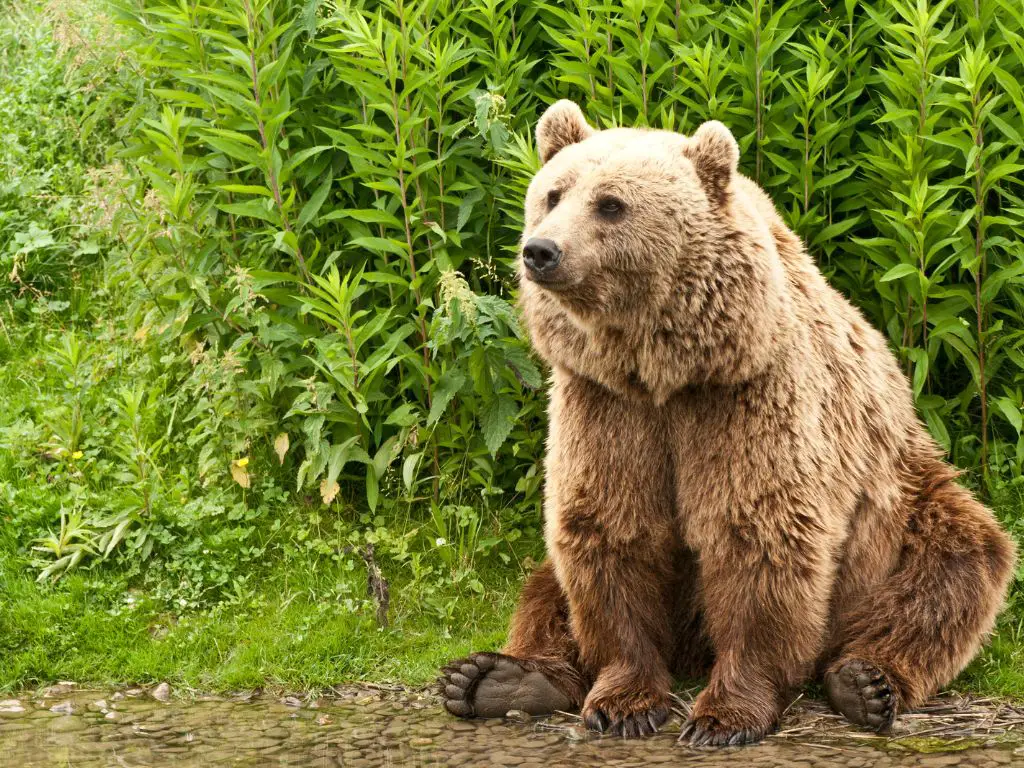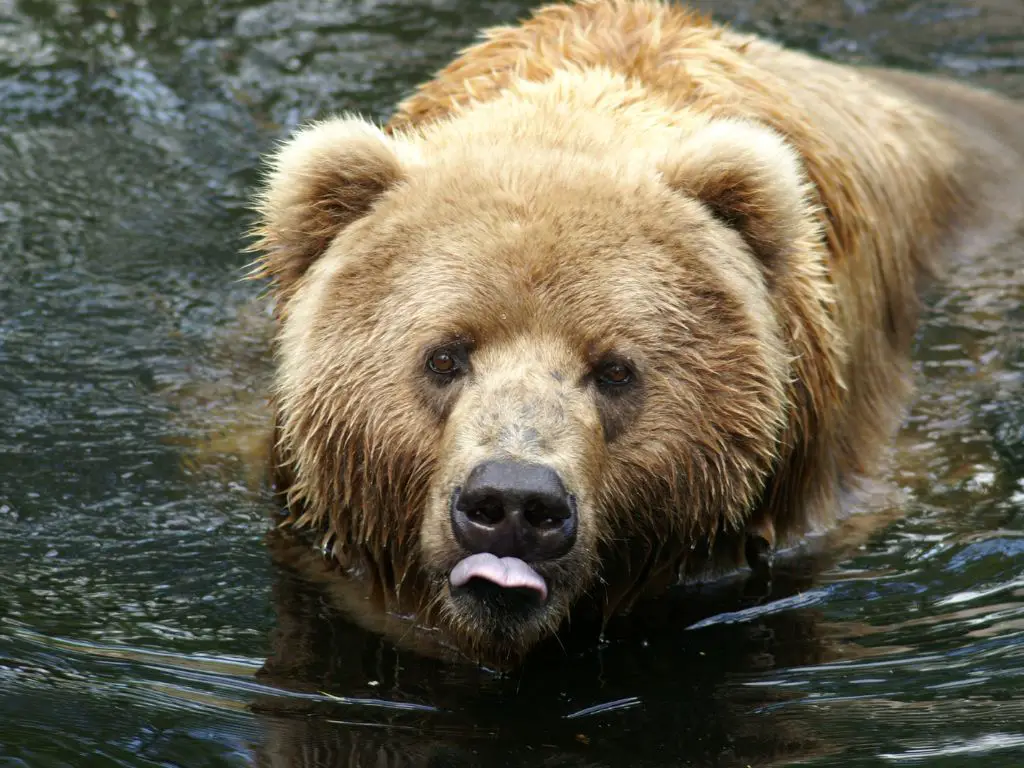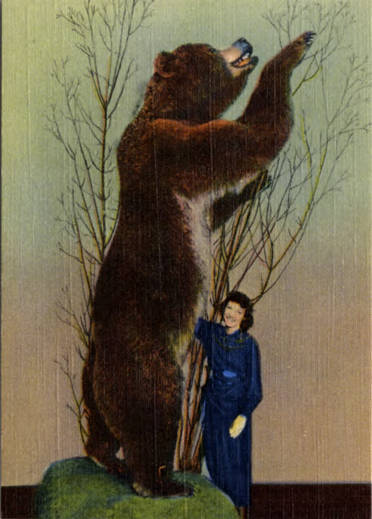The Kodiak bear is one of the largest land predators in North America. It is a subspecies of the brown bear, and it inhabits the islands off Alaska’s southern coast. Kodiaks have thick fur that helps keep them warm during cold Alaskan winters as well as waterproofing their coat for swimming or fishing activities they may engage in during warmer months. They also have incredibly sharp claws which help them climb trees and dig burrows into snow banks where they will hibernate throughout wintertime if food becomes scarce or temperatures become too extreme for survival outside their denning areas.
How Big Is A Kodiak Bear
The average male Kodiak can reach up to 11 feet tall when standing on its hind legs, and weigh between 600-1500 pounds. This makes them larger than even some polar bears! Females are usually smaller but still impressive in size, weighing anywhere from 400-700 pounds with an average height of 8 feet tall while standing upright.

Average size of a kodiak bear
How tall is a kodiak bear
- Male Kodiak Bears are 4 to 5 feet (1.22-1.52 m) in height when standing on all four legs.
- Female Kodiak Bears are 3.4 to 4 feet (1.02-1.22 m) in height when standing on all four legs.
Body Length of Kodiak Bear
The Kodiak Bear body length is about 6.5 to 9 feet (1.96-2.74 m).
How tall is a kodiak bear standing up
When standing up the height of a kodiak bear is 9 to 10 feet (2.75-3.05 m).
How heavy is a kodiak bear
- Male Kodiak Bears weighs about 600 to 1400 pounds (272-635 kg).
- Female Kodiak Bears weighs about 400 to 700 pounds (181-318 kg).

Why are kodiak bears so big
Kodiak bears are found exclusively on Alaska’s Kodiak Island, where they have been isolated from other bear species for thousands of years. This isolation has resulted in some unique adaptations that have allowed these bears to become so large and powerful. Several factors contribute towards why kodiaks are so big including their nutrient-rich diets coupled with minimal competition amongst predators allowing for faster growth rates than those experienced elsewhere in North America making it possible these majestic creatures attain such impressive sizes over time!
The first factor contributing to their size is their diet, which consists mainly of fatty salmon as well as a variety of berries, roots, insects and small mammals. The high-fat content in salmon provides them with ample energy reserves during hibernation season when food sources may be scarce or difficult to access due to frozen ground conditions or deep snowfall accumulation on the island’s mountainous terrain . Additionally , this rich diet allows them grow quickly throughout summer months when food is abundant, enabling them reach full adult size by age five.
Another contributor is the lack competition among predators within its habitat range; grizzly bears inhabit mainland Alaska but not Kodiak Island making it a safe haven for kodiaks since they don’t need compete with larger predatory animals like wolves or cougars who would otherwise hunt down prey more efficiently than kodiaks could. Furthermore , because there aren’t any natural predators present on Kodiak island aside from humans – meaning no animal needs worry about being hunted by another creature – this encourages greater growth potential among individuals without fear predation hindering such development.

Is a kodiak bear bigger than a grizzly bear
Kodiak bears and grizzly bears are two of the largest land carnivores in North America. Both species have large bodies, powerful jaws, and sharp claws that make them formidable predators. But which one is bigger?
The answer to this question is yes; Kodiak bears are generally larger than grizzly bears.
- Kodiak Bears are 4 to 5 feet (1.22-1.52 m) in shoulder height when standing on all four legs while Grizzly Bears are 3.6 to 4.6 feet (1.07-1.37 m).
- Kodiak Bears weighs about 600 to 1400 pounds (272-635 kg) while Grizzly Bears weighs about 400 to 800 pounds (181 -363 kg).
- Kodiak Bear body length is about 6.5 to 9 feet (1.96-2.74 m) while Grizzly Bears body length is about 5.6 to 8 feet (1.68-2.44 m).
- When standing up the height of a kodiak bear is 9 to 10 feet (2.75-3.05 m) while that of Grizzly Bears is 8 to 9.9 feet (2.5-3 m).

This size difference results from a combination of factors including diet availability as well as genetic differences unique to each subspecies of bear found across Alaska and Canada’s remote regions where these animals live in relative isolation from other populations for long periods of time.
How big does a kodiak bear get – Biggest kodiak bear ever recorded
The biggest Kodiak ever recorded in the wild was a massive male that weighed in at 1,600 pounds and stood over 10 feet tall when it was shot on Afognak Island in Alaska back in the 1950s. This record-breaking beast has become legendary among hunters, wildlife enthusiasts, and conservationists alike for its sheer size and power.

The biggest Kodiak ever recorded in the captivity was Clyde. This Kodiak bear lived at the Dakota Zoo in Bismarck, North Dakota, and was the largest known bear of his species. When he passed away in June 1987 at the age of 22, he weighed an impressive 2130 pounds. The zoo director, Terry Lincoln, estimates that Clyde weighed almost 2400 pounds the previous year. Even at the time of his death, he had a thick layer of fat measuring 9 inches.


Leave a Reply